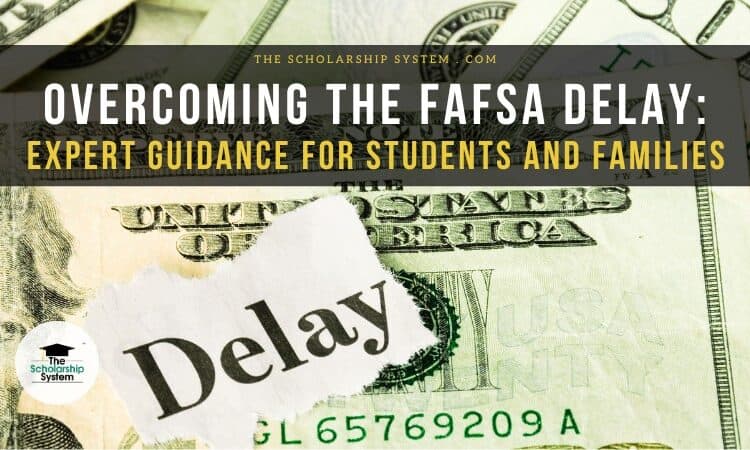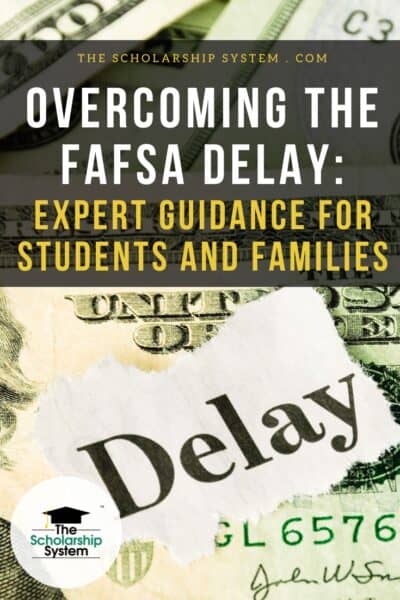Updated on August 1st, 2024
Errors, glitches, and processing delays in the redesigned Free Application for Federal Student Aid (FAFSA) have left many families anxious and uncertain. Initially, about 30% of submitted forms faced significant setbacks due to data and processing errors, and these struggles slowed down the release of critical financial information to students’ schools. As a result, financial assistance packages were also delayed. The Government Accountability Office has started an investigation into the implementation of the new FAFSA form by the Department of Education.
As a parent, understanding these obstacles can be crucial to securing your student’s financial aid and ensuring their academic journey stays on course. Here’s what you need to know.
If you and your student want to learn about college scholarships, sign up for our free college scholarship webinar! Take a quick trip over to http://thescholarshipsystem.com/freewebinar to reserve a spot today.
Contents
 Understanding the FAFSA Delay
Understanding the FAFSA Delay
Causes of the delay: processing issues and errors
The redesigned FAFSA has been plagued by processing issues and errors, primarily due to data and processing mishaps by the Education Department. These problems have caused significant delays, particularly affecting dependent students with assets, families who claimed education tax credits, and those with amended tax returns. The Government Accountability Office is investigating these delays caused by the Education Department’s processing issues.
FAFSAs featuring parents without Social Security Numbers also experienced issues. Students with mixed-status families struggled to complete a critical portion of the application, making them unable to submit the form and move toward federal student aid awards.
Impact on students and families: delayed financial aid awards
As students and families eagerly awaited financial aid packages, delays in FAFSA processing caused considerable stress. With the traditional May 1 college decision deadline, the inability to complete FAFSA applications in a timely manner worried many. Plus, some types of aid had priority deadlines or came from a limited pool, making it essential for families to navigate these delays efficiently to ensure their students received the necessary financial support for their education.
Additionally, colleges had to navigate the situation, causing many to delay when they sent financial aid awards. Essentially, the traditional timeline for these decisions was impossible to maintain, impacting students, families, and many schools.
In response, some universities and colleges pushed back deposit deadlines, creating more time to send out financial aid award letters before students made critical decisions about where to pursue their degrees. Some high schools also arranged FAFSA workshops to assist students struggling with the new “Better FAFSA” from the Department of Education.
Key changes to the 2024-25 FAFSA and creating an FSA ID
The new FAFSA form results from changes approved by Congress in 2019 and 2020, aimed at making it shorter and simpler. The redesigned form has reduced the number of questions from 108 to as few as 18, allowing it to be completed in less than 10 minutes.
The number of questions the FAFSA features depends on how specific questions are answered. This approach makes the application dynamic, ensuring students and parents can bypass questions that don’t apply to their households.
All contributors to a student’s FAFSA – including parents – will need an FSA ID, which streamlines the process and ensures secure access to the application. As part of the process, the FSA ID must be verified before the contributor can handle their part of the FAFSA.
The 2024-2025 FAFSA also uses the Direct Data Exchange (DDX) instead of the previously used Data Retrieval Tool. With the DDX, students and parents could import specific information directly from their records at the IRS, reducing the need for manual data entry.
Additionally, the new FAFSA is available in more languages than previous versions. As a result, this makes it easier for many contributors and students who primarily speak languages other than English or Spanish to navigate the FAFSA forms.
Finally, the new FAFSA form has led to an estimated increase in the number of students qualifying for the federal Pell Grant, particularly those from low-income families. More students can access the federal Pell Grants than in previous years. Also, more students from low-income families qualify for the maximum Pell Grant, giving them more federal student aid than in years past.
Tips for completing the FAFSA successfully and avoiding common mistakes
To complete the FAFSA successfully, gather all necessary documents and information, including Social Security numbers, tax returns, and income statements. Ensure that all contributors, such as parents or guardians, have created an FSA ID, which is essential for signing the form electronically.
Additionally, completing the FAFSA in one sitting is best to minimize the risk of losing progress or encountering technical issues. Double-check all entries for accuracy, especially names, dates of birth, and Social Security Numbers, as even minor errors can delay the processing of an application. The National Association of Student Financial Aid Administrators recommends double-checking all entries for accuracy to avoid delays.
Avoid common mistakes by carefully reading and following the instructions for each section. Be sure to include all required financial information, even if it seems redundant. If students or parents encounter any difficulties, they should take advantage of the resources available, such as the FAFSA website, financial aid offices, or organizations like the National College Attainment Network (NCAN). These resources offer valuable guidance and support to help you navigate the application process smoothly.
By being thorough and attentive, students and parents can ensure the FAFSA is completed accurately, increasing students’ chances of receiving the financial aid they need.
Maximizing Federal Student Aid
Understanding the Student Aid Index and its impact on financial aid eligibility
The Student Aid Index (SAI) has replaced the Expected Family Contribution (EFC) as the key measure of a student’s financial need. Colleges use the SAI to determine the amount of federal financial aid they will extend to a student. Additionally, the SAI often influences the allocation of institutional and state financial aid, making it a crucial factor in maximizing the financial support available for your student’s education. The SAI also impacts eligibility for the federal Pell Grant, which is essential for many low-income families.
Leveraging the IRS Direct Data Exchange (DDX) for accurate information
The IRS DDX allows the IRS to share Federal Tax Information (FTI) directly with the Department of Education and the colleges listed on a student’s FAFSA. This integration streamlines the FAFSA application process, making it easier and faster while reducing the likelihood of errors. Utilizing the DDX ensures that accurate financial information is used, which is essential for maximizing your student’s eligibility for financial aid. The Government Accountability Office is also reviewing the implementation of the IRS Direct Data Exchange as part of its investigation into the FAFSA delays.
Optimizing financial aid with expert guidance from student financial aid administrators
Students and families can benefit significantly from expert guidance available through the FAFSA website, college or university financial aid offices, and other resources. Financial aid administrators offer invaluable advice on maximizing federal student aid and navigating the complexities of the FAFSA process. Leveraging their expertise can help ensure that your student secures the maximum amount of financial assistance available, providing crucial support for their educational journey. The National Association of Student Financial Aid Administrators provides expert advice on maximizing federal student aid.
Overcoming Common Challenges
Addressing mixed-status family glitches and correcting submitted FAFSAs
A technical glitch left millions of students in limbo by preventing undocumented parents of U.S. citizen students from completing their portion of the FAFSA for months. In March, the Education Department shared a workaround that allows contributors without Social Security numbers to complete their FAFSA sections.
Currently, students are advised to have contributors who don’t have a valid SSN – including parents with an Individual Taxpayer Identification Number (ITIN) – enter financial information manually. This solution has been crucial for resolving issues and ensuring that affected students can access the federal aid they need. The National Association of Student Financial Aid Administrators offers resources to help mixed-status families navigate these challenges.
Reviewing dependency status and resolving technical issues
Understanding dependency status is key to accurately completing the FAFSA. Dependent students must include their parent(s) as contributors, while independent students do not. Accurate dependency status information is crucial for determining eligibility for the federal Pell Grant.
You are considered a dependent student unless you meet specific criteria, such as being a ward of the state, an orphan, in foster care, or having a legal guardian. Clarifying your status and resolving any technical issues is essential for ensuring your FAFSA is processed correctly and on time.
Getting Help and Support
Resources for students and families: FSA, NCAN, and college financial aid offices
The National College Attainment Network (NCAN) has curated a comprehensive list of issues, challenges, and workarounds to help students navigate the new FAFSA process. In addition, students and families can receive free assistance and advice from the Federal Student Aid (FSA) website, college financial aid offices, and other resources. These supports are invaluable for addressing any difficulties that arise, ensuring students receive the financial aid they need for their educational journey.
Frequently asked questions about the new FAFSA and where to get help when you need it
Confused about the new FAFSA? You’re not the only one. Here are some commonly asked questions about the process.
Do people make mistakes on FAFSA?
Yes, mistakes on the FAFSA aren’t uncommon, but errors can delay the processing of a student’s FAFSA forms and affect their federal student aid eligibility. As a result, it’s crucial for students to take their time when completing the forms. The National Association of Student Financial Aid Administrators recommends double-checking all entries to avoid common mistakes.
What if there is an error on my FAFSA?
If your student discovers an error on their FAFSA, correcting it as soon as possible is essential. They must log into their FAFSA account, make the necessary changes, and resubmit the form to avoid delays in financial aid processing.
How many times can you correct your FAFSA?
Students can correct their FAFSAs as many times as needed, but there is a caveat. Corrections are only an option once the current application or correction is processed. As a result, while unlimited corrections are technically allowed, time isn’t on students’ side if multiple corrections create many processing periods.
Reprocessing delays the completion of their FAFSA, which can cause them to miss out on bigger financial aid awards. As a result, each time students make corrections, it’s vital to review the information thoroughly to ensure accuracy before resubmitting. The National Association of Student Financial Aid Administrators offers guidance on making corrections to the FAFSA.
Where can I get help when completing the FAFSA?
Help is readily available through the FAFSA website, college financial aid offices, and organizations like the National College Attainment Network (NCAN). These resources offer free advice and support to guide you through the FAFSA process and resolve any issues that may arise.
Conclusion
Ultimately, issues with the new FAFA are undeniably concerning, but fixes are regularly released to address problems. Additionally, states and institutions also did their part. The U.S. Department of Education’s “Better FAFSA” rollout prompted states to extend their filing deadlines, providing students and families with additional time to complete the form and make college attendance decisions. Many institutions have also postponed their May 1 deposit deadlines. The federal deadline to file the FAFSA remains June 30, 2025.
If you and your student want to learn about college scholarships, sign up for our free college scholarship webinar! Take a quick trip over to http://thescholarshipsystem.com/freewebinar to reserve a spot today.









Leave a Reply